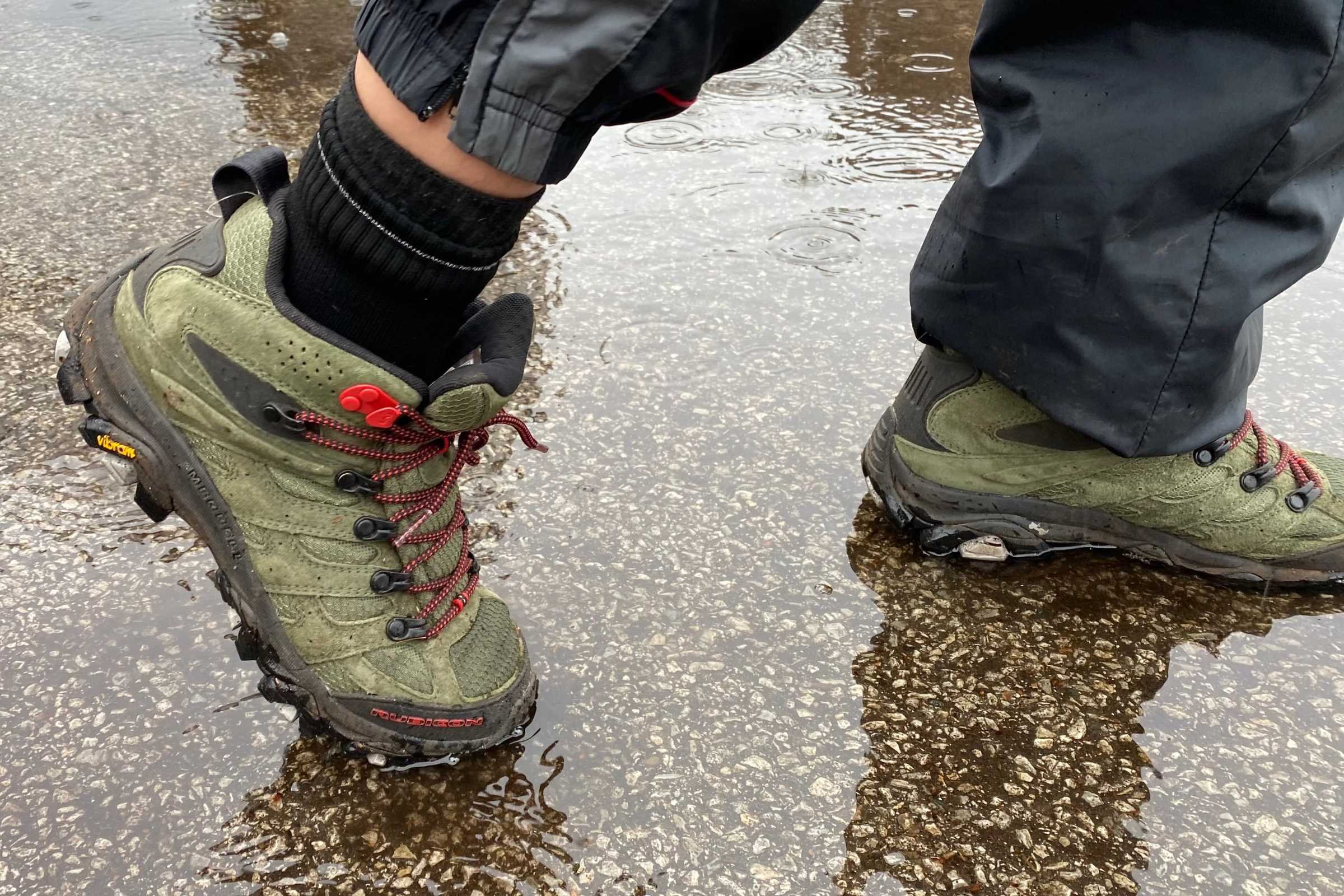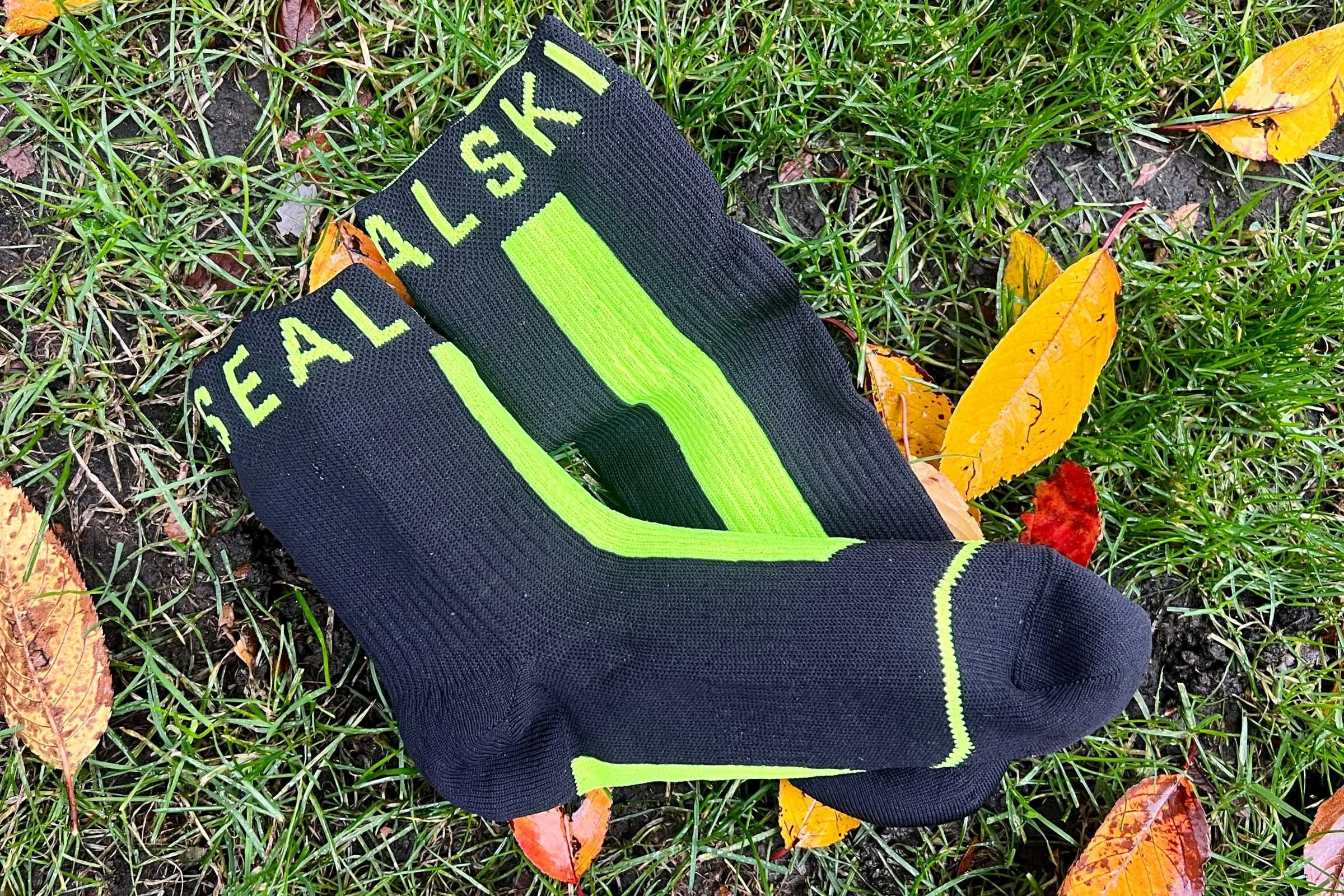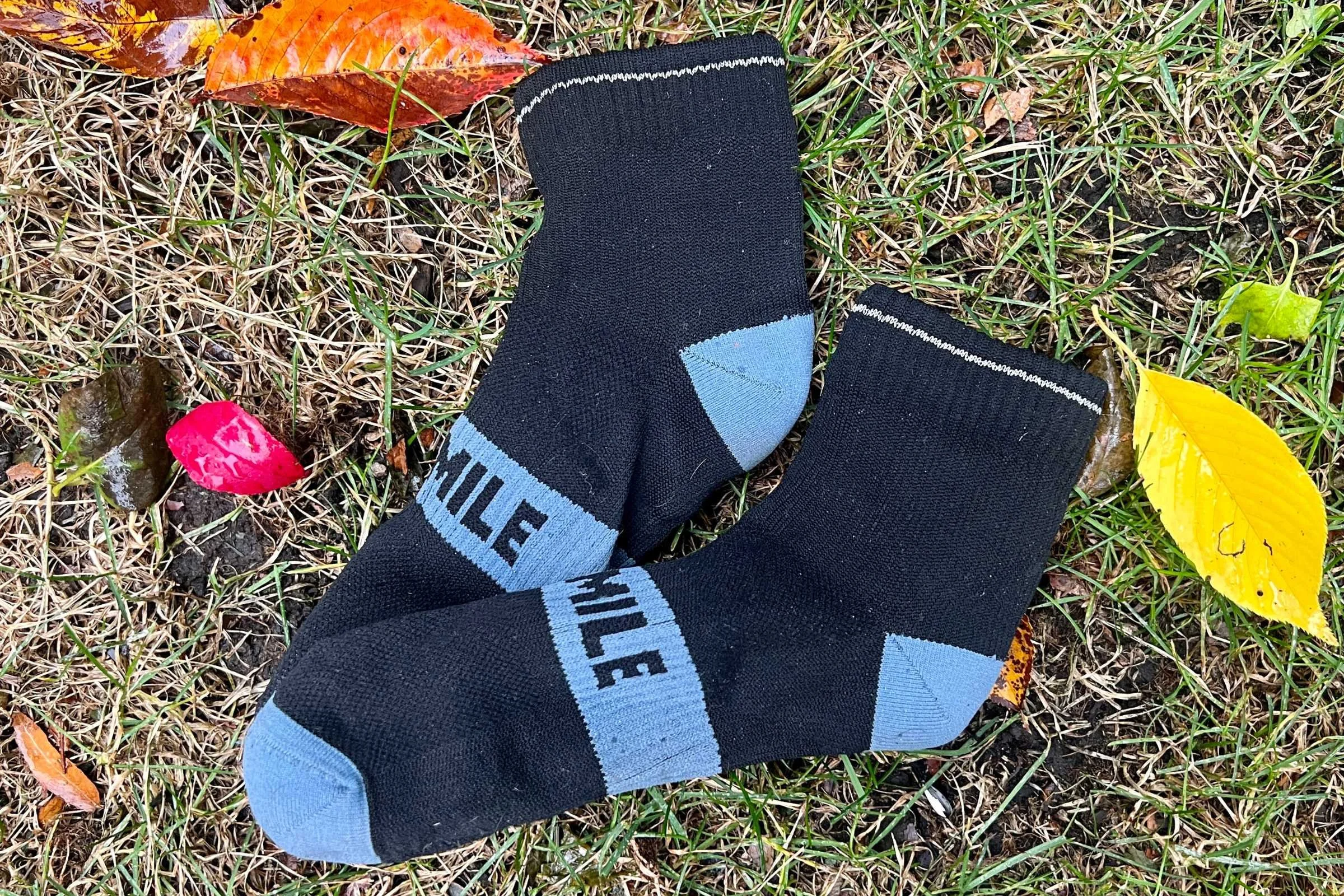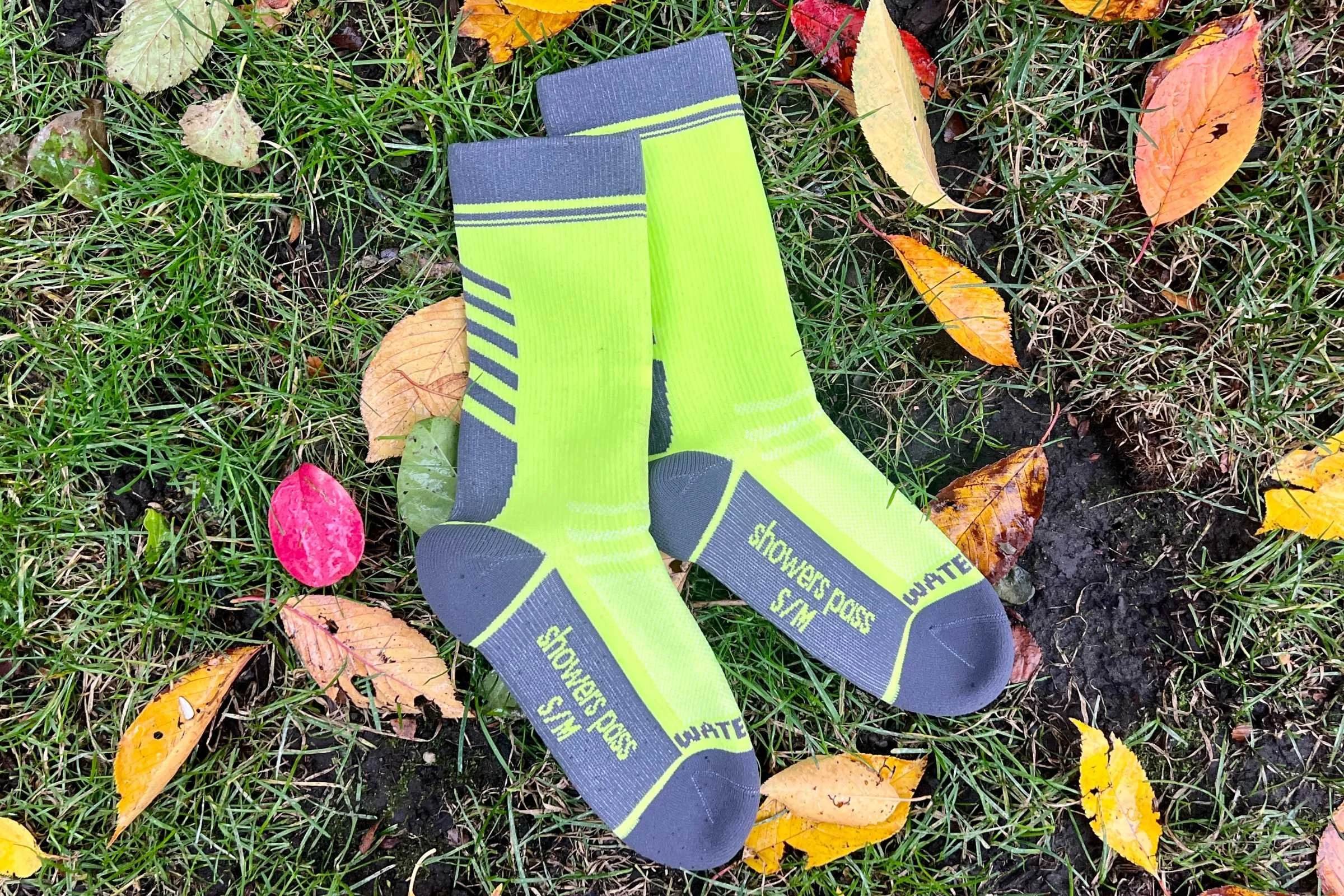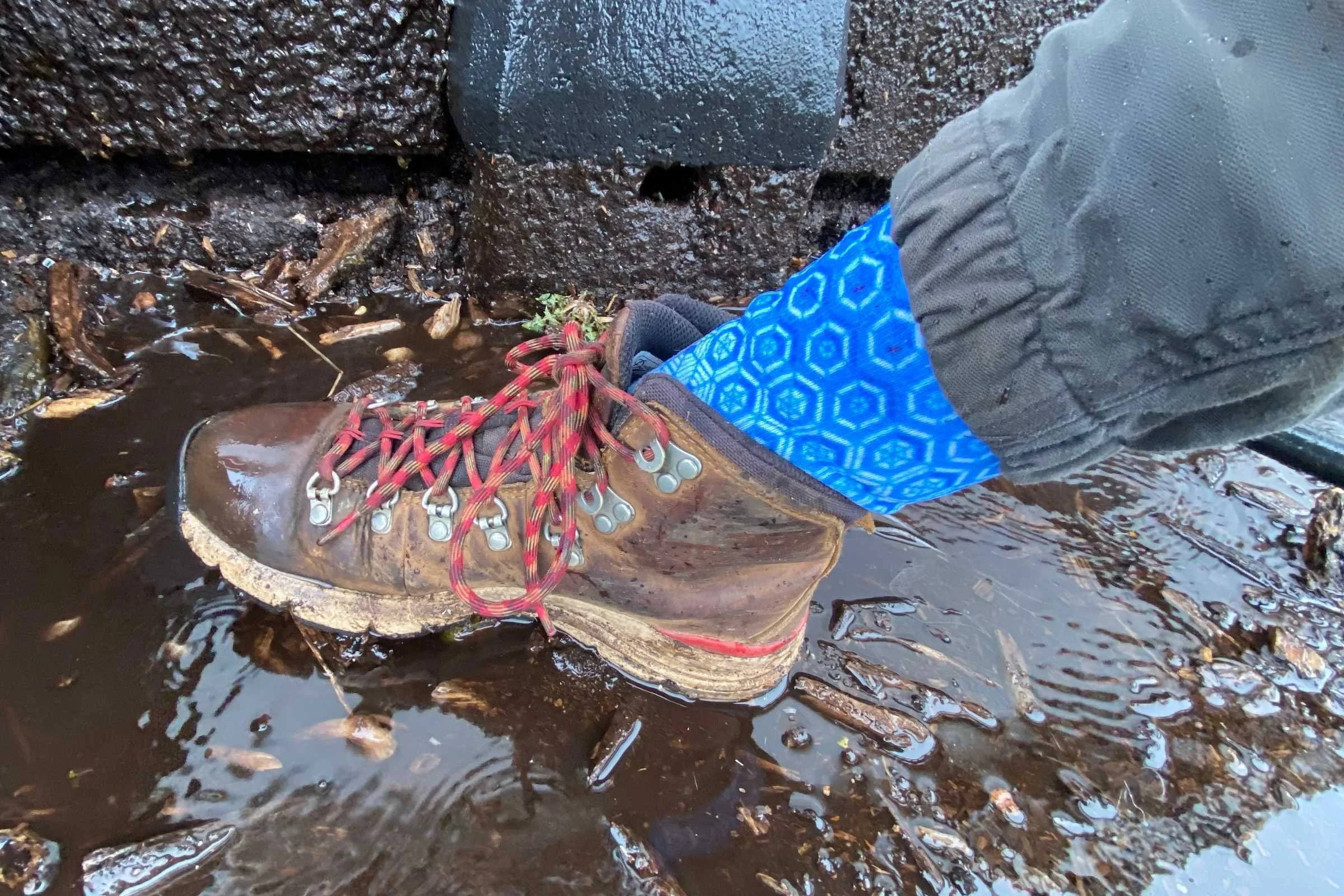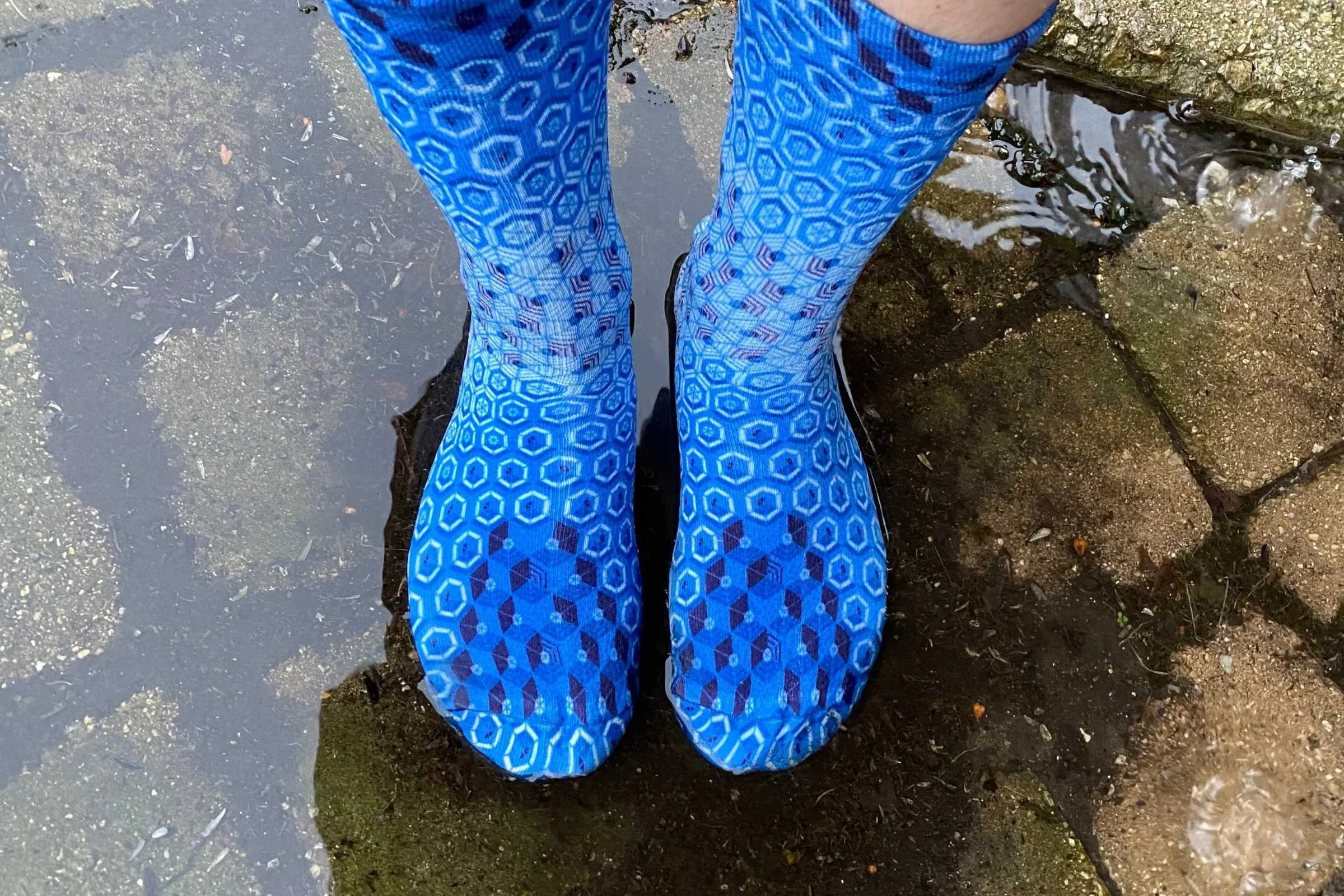Best Waterproof Socks of 2025/26
Versatile, durable and waterproof socks for hiking, running, and biking
November 18th, 2025, with new overall winner and to remove discontinued products
Home > Gear Reviews > Apparel
Waterproof socks aren’t gimmicks—they’re essential when wet feet ruin hikes, rides, or cold-weather adventures. The right pair blocks moisture while staying breathable, cushioning sensitive areas, and enduring repeated use in rain, snow, or damp trails.
Treeline’s testers put six waterproof socks through real-world conditions—everything from 70-mile bike rides in unrelenting downpour to wet hikes through muddy trails. They dunked pairs in water to gauge resistance and drying time, and ran them under real stress so we could see which ones actually keep feet dry and comfortable when it matters.
In assessing each sock, we focused on comfort across the foot (cushioning in arch, heel, toe), waterproofing and quick-dry performance, fit (especially at cuffs and height), durability against abrasion and seam stress, and breathability so heat and moisture escape. The best socks blend all these traits without making compromises you’ll notice under load.
Top Pick: The SealSkinz Dunton Waterproof All Weather Ankle Length Sock with Hydrostop earns Treeline’s Best Overall waterproof sock. It stood out for its exceptional comfort, cushioning, wide yet secure fit, ability to dry quickly, and resilience even after hours in a downpour—showing the most consistent balance of protection, wearability, and durability across all our tests.
If you’re interested in warm, wool socks for cold weather, check out our Best Winter Socks guide.
We create reader-supported, mission-driven objective gear reviews that are independently selected by our editors. This story may contain affiliate links, which help fund our website. When you click on the links to purchase gear, we may get a commission — without costing you an extra cent. Thank you for supporting our work and mission of outdoor coverage for every body! Learn more.
Comparison Table
| WATERPROOF SOCKS | TREELINE AWARD | AVAILABLE SIZES | HEIGHTS AVAILABLE | OUTER MATERIAL | MEMBRANE / MID-LAYER MATERIAL | MID / INNER MATERIAL | MSRP* |
|---|---|---|---|---|---|---|---|
| SealSkinz Dunton Waterproof All Weather Ankle Length Sock with Hydrostop | Best Overall Read why |
S - XL | ankle | 90% Nylon, 10% Elastane | Aquasealz® waterproof membrane | 36% Merino Wool, 36% Acrylic, 18% Polyester, 5% Elastane, 4% Nylon, 1% TPU | $42 |
| RANDY SUN 2.12oz Ultra Thin Breathable Waterproof Socks Mid Calf Quick Dry | Best Ultralight Read why |
XS - L | crew | 96% polyester, 4% Elastane | 100% PU waterproof and breathable membrane | 96% Polypropylene, 4% Elastane | $28 |
| DryMile Active waterproof socks | Best for Running and Trail Running Read why |
XS - XL | ankle | 96% Nylon / 3% Spandex 1% Reflective Yarn | not stated | 75% Bamboo Charcoal / 21% Polyester / 4% Spandex | $30 |
| Endura Hummvee Waterproof Socks II | Best for Mountain Biking and Biking Read why |
S - XL | crew | Elastane 13%, Polyester 42%, Nylon 45% | not stated | not stated | $60 |
The Winners
Best waterproof socks: Sealskinz Dunton All Weather Ankle Sock with Hydrostop
Material: 90% Nylon, 10% Elastane
Price: $42
Height options: ankle
Available sizes: S - XL
What we liked: Technical Hydrostop elastic taping to secure sock to ankle and prevent water from getting in, durable, and washable
What we didn’t like: Expensive, inner material is less comfortable than other socks because it uses higher percentage of acrylic and polyester material
One of the most technical waterproof socks we tested, the Dunton uses Sealskinz’s Hydrostop technology. This design element features elastic taping around the inside cuff of the sock to help act as an extra barrier to reduce water dripping down the leg and into the cuff of the sock.
These socks are ideal for hiking and backpacking, when you’re most likely to be moving on varied terrain that may normally cause the cuff of the sock to shift and move while you hike. The Hydrostop elastic helps prevent the risk of water getting inside of your sock by keeping it secure around your ankle.
These socks performed best while hiking in rainy conditions, keeping moisture out of the inside of my socks in a steady rain while hiking on trails in and around Chicago. We found they dried quickly after taking them off and leaving them to air dry. Another feature I appreciated was their low-maintenance care and treatment. You can tumble dry these socks on low heat, and because they’re built with durable membrane, you don’t need to re-waterproof them throughout their lifetime.
Sealskinz Dunton All Weather Ankle Sock with Hydrostop
Sealskinz Dunton All Weather waterproof ankle sock with Sealskinz’s proprietary Hydrostop water guard fend off water seepage better than most.
In terms of breathability, the Sealskinz Dunton socks were overall more breathable than the Bridgedale StormSock. However, they were also much less padded and cushioned because of their lighter weight and streamlined design. If you’re looking for a lighter weight sock and are OK with less cushion underfoot while you hike, make the Dunton your pick.
Best ultralight waterproof socks: RANDY SUN Ultra Thin Mid Length
Material: 96% polyester, 4% Elastane
Price: $37
Height options: crew
Available sizes: XS - L
What we liked: Super ultralight and thin, ideal for adventures in hot and humid weather
What we didn’t like: Not as water resistant as other models we tested, scratchy (almost plastic-like) material that’s not as soft
The thinnest and lightest of all the socks we tested was the RANDY SUN Ultra Thin, weighing 2.12oz. These ultralight, ultra-thin waterproof socks are ideal when you are hiking in hot, humid temperatures or you want to bring a pair of lightweight waterproof socks on the trail for long-distance backpacking trips or thru-hikes. They’re one of the thinnest, if not the thinnest, waterproof socks you can find on the market.
RANDY SUN Ultra Thin Mid Length
RANDY SUN Ultra Thin Mid Length waterproof socks were, by far, the thinnest and lightest weight socks of our testing pool.
The RANDY SUN Ultra Thin socks are especially ideal for summer and warm-season hiking, biking, and/or running. However, their durability is slightly challenged because of their thinner build. We also found these socks did not dry as quickly as competitors like the Bridgedale StormSock, even though they’re a thinner sock. This has to do with the material they’re made of, which is 96% polypropylene. You might also be unwilling to buy these socks as polypropylene contains PFAs chemicals or “forever chemicals,” which have a negative impact on the environment.
While most people recommend wearing a liner sock underneath waterproof socks for comfort and extra warmth, I found that these socks don’t need it and feel comfortable without a liner. Still, we recommend normal-thickness waterproof socks, like the Sealskinz Dunton or Bircham, for long-distance hiking and trekking though, as they will be more durable over time.
Best waterproof socks for running and trail running: Drymile ACTIVE
Material: 96% Nylon / 3% Spandex 1% Reflective Yarn
Price: $30
Height options: ankle
Available sizes: XS - XL
What we liked: Ultra stretchy, highly breathable and impressive odor control due to bamboo charcoal interior material
What we didn’t like: Only comes in one height, extra breathability compromises long-term waterproofing slightly compared to thicker competitors
These highly breathable and stretchy waterproof socks are ideal for trail runners and road runners looking to keep their feet dry in wet conditions. Even if rain is looming but it’s not quite drizzling yet, these socks are breathable enough to wear while running in dry conditions before a forecasted storm. The Drymile ACTIVE socks were, by far, more breathable than all other socks we tested. Even in humid and rainy conditions, my feet didn’t get overwhelmed with sweat while hiking upwards of 5 miles in these socks (and even with a thin layer of merino wool socks underneath).
Drymile ACTIVE
Your feet will certainly heat up in these socks while you work out. However, they’re thoughtfully designed to include thinner fabric on the top and arch of the foot for added breathability. Even in super damp and muggy conditions in early summer rain, my feet stayed much drier and airy in these socks as compared to others like the thicker and less-breathable Sealskinz Dunton. Especially paired with a waterproof trail runner or hiking boot, helping prevent your foot from getting completely soaked, you have nothing to worry about when it comes to breathability in these waterproof socks.
The ACTIVE also have an extra cushioned toe and heel for high-impact areas while running. A thinner, stretch design around the arch and top of the foot allow your feet to expand in the sock with less restriction than some of the more ridged and thick socks we tested, like the Sealskinz Dunton and Bircham, which are more suited for hiking.
A thicker ankle cuff on these socks, featuring a dry guard strip, protects from water running down from the leg and into the interior of the sock. I will say, the elastic strip is more stiff, and not as grippy or soft as the Sealskinz Dunton. So, keep this in mind if you’re more eager to have a sock with a higher-performing elastic guard, which would mean you should opt for the Dunton over the ACTIVE.
The highly stretchable and breathable Drymile ACTIVE waterproof socks are ideal for hiking thanks to added cusion on the toe and heel.
Best waterproof socks for biking and mountain biking: Endura Hummvee II
Material: Elastane 13%, Polyester 42%, Nylon 45%
Price: $50
Height options: crew
Available sizes: S - XL
What we liked: Highly elastic to allow for better movement and less restriction, thin construction ideal for fitting inside of a bike shoe or hiking boot, versatile
What we didn’t like: Expensive, only comes in one length
Mountain bikers, gravel bikers, road bikers, and bikepackers will love these socks for their long leg length for maximum coverage, thin design that helps fit under traditionally tighter-fitting bike shoes, and the ability to keep your feet dry and happy en route no matter the weather. In addition to biking, I found these socks are thin enough to fit well inside of my bulky fly fishing boots yet are warm enough to keep my feet regulated, even in the shoulder fishing seasons.
These thin, stretchy socks are waterproof yet durable and thick enough to keep your feet warm in cold conditions. Because of their composition with a mix of nylon, polyester, and elastane, they’re highly stretchy. That helps with movement as you pedal through tough terrain and accommodate your feet as they move in your bike shoe while you ride, especially over long distances.
Endura Hummvee II
The best choice bikers of all kinds—mountain, gravel, and road—the Endura Hummvee II are a super durable, lightweight waterproof sock.
These socks strike a balance between comfort and performance, and even if it’s not raining, you’ll feel comfortable while wearing these socks on a ride. They’re noticeably soft thanks to an inner yarn inner lining and snug fit that hugs your foot without adding unnecessary material that you’d otherwise need to somehow fit in your bike shoe (or hiking boot). When you slide your feet inside, the Hummvee II socks feel more like a normal sock than a stiff, scratchy waterproof sock. Even if you want to wear these without a liner sock, you can get away with doing so without feeling discomfort.
Other waterproof socks we tested
Showers Pass Lightweight Cross Point
Material: 74% Polyester, 19% Cotton, 2% Spandex, 4% Nylon, 1% Lycra
Price: $30
Height options: mid-calf
Available sizes: S - XXL
What we liked: Soft inner lining, high waterproof performance
What we didn’t like: Stiff and lacks stretch, higher price point, only comes in one height
The Goldilocks of waterproof socks, the Showers Pass Cross Point Essentials Stripe socks are not too thin, not too thick, but just right. A lighter-weight version of the top-selling Shower Pass Cross Point socks, which are made of a wool blend, the Showers Pass Crosspoint Essentials Stripe socks are ideal for endurance activities like long-distance hiking, road and trail running, and more.
These socks perform especially well if your feet tend to sweat a lot while you exercise and participate in outdoor activities. Their three-layer design is made up of a knit exterior, a waterproof yet breathable membrane (called Artex), and a moisture-wicking anti-bacterial lining (called Coolmax FX). The combination results in a highly breathable and highly waterproof sock.
If you’re looking for an even more minimalist, lighter version of the Essentials sock, check out the Cross Point Superlight. These are the lightest waterproof socks Showers Pass makes and are best used when outdoors in warmer weather or participating in high-endurance activity.
Showers Pass Cross Point Essentials Stripe
Consider the Showers Pass Cross Point Essentials Stripe if you want a sock that will work on the trail, on your bike, or in the mountains. They stand out for their lightweight and sleek fit.
These socks perform especially well if your feet tend to sweat a lot while you exercise and participate in outdoor activities. Their three-layer design is made up of a knit exterior, a waterproof yet breathable membrane (called Artex), and a moisture-wicking anti-bacterial lining (called Coolmax FX). The combination results in a highly breathable and highly waterproof sock.
If you’re looking for an even more minimalist, lighter version of the Essentials sock, check out the Cross Point Superlight. These are the lightest waterproof socks Showers Pass makes and are best used when outdoors in warmer weather or participating in high-endurance activity.
Material: 62% Polycolon, 29% Nylon, 9% Elastane
Price: $49
Height options: ankle
Available sizes: S - XL
What we liked: Versatile across seasons and activity, roomy enough to fit thicker socks underneath in colder conditions
What we didn’t like: Stretches when wet, less fitted around the foot, less cushion
If you’re looking for a sock that will perform across seasons (especially the wet and cold ones), opt for the Sealskinz Bircham All Weather. They’re light and breathable enough to serve as a throw-on sock during a summer rainstorm but roomy enough to slide over a thick wool sock in the winter months when there’s a noticeable chill in the air. I wore these socks while biking in the rain and walking around my neighborhood, and I appreciated their versatility to keep my feet protected no matter where I was adventuring.
Sealskinz Bircham All Weather Ankle Length
These socks are less waterproof than top winners, like Bridgedale StormSock and Sealskinz Dunton, but certainly perform in moderate conditions, like on-and-off rain while hiking or a brief downpour while biking. The Sealskinz Bircham socks are also made with a thick, merino wool lining for added sweat-wicking and odor-fighting properties.
The ankle height on these socks was also a standout, falling in between a high sock and an ankle sock. They’re an ideal match in height for mid-height boots or extra protection above the ankle if you’re wearing smaller shoes like bike shoes or low-cut hiking shoes.
When to use waterproof socks
A hiker tests out the Drymile ACTIVE on a particularly rainy Midwest day, finding they kept their feet not only dry but warm in chilly temps.
Waterproof socks are a niche piece of gear, but in the right conditions they can make the difference between finishing your trip in comfort or slogging home with frozen, wrinkled feet. They work best in situations where your footwear alone can’t keep moisture out:
All-day rain: Even the best trail runners and hiking boots will eventually wet through in hours of steady rain. A waterproof sock adds a final barrier between your foot and the elements.
Mud and slush: On shoulder-season trails or during spring melt, waterproof socks keep your feet dry when mud and melting snow push in through mesh shoes.
Snow travel: If you don’t have insulated boots, a waterproof sock can help keep snowmelt from chilling your feet. Pair with a warm liner sock for extra insulation.
Water crossings: Shallow creeks or boggy meadows are less of a worry when you know your socks won’t instantly soak through.
That said, waterproof socks are not an everyday replacement for wool hiking socks. They run warmer than standard socks and can feel clammy in hot weather. They also can’t stop water from pouring in over the cuff if you wade too deep. For most hikers, runners, and bikers, waterproof socks are a problem-solving piece of gear: stash them in your pack and pull them on when you know you’ll be in hours of rain, snow, or mud.
If you want to extend their usefulness, combine waterproof socks with gaiters or rain pants to seal off the top and prevent water from sneaking in at your ankles. And always keep a dry backup pair of regular socks in your kit — just in case conditions outlast even the best waterproofing.
What to look for in waterproof socks
Consider whether you want a lightweight sock that will wick moisture in the heat or a thicker sock that fends off winter temperatures.
Here are the criteria that every good pair of waterproof socks must have to rest assured your feet will stay safe, protected, and dry on your adventures:
Material
Materials play a big role in the overall performance, durability, fit, and comfort of a waterproof sock. According to the Portland brand Showers Pass, waterproof socks are typically constructed with three key elements: knit exterior, waterproof membrane, and knit interior.
In general terms, the combination of material used in the design and the thickness of the sock is what gives them their waterproof quality. The outer layer will get wet to the touch, but it’s the inner and middle layers that provide the extra barrier to keep water from seeping in. Waterproof socks tend to be constructed with thicker, scratchier,materials like nylon, elastane, and polyester, rather than natural fibers like merino wool and cotton. Some waterproof socks incorporate a DWR treatment.
The material also plays a role in fit and comfort.
Fit
Like Goldilocks, we tested the fit of these waterproof socks to make sure they’re comfortable on the foot: not too loose, not too tight, but just right. We also made sure to test with different socks underneath.
Waterproof socks typically come in ankle, quarter, mid-calf, and over-the-calf heights, with the majority on the taller side as they provide more coverage and protection. While sock height preference is based on several factors — from type of shoe or boot to activityto personal preference — we tested a variety of sock heights to gauge their fit and feel.
We also considered if a sock was too tight around our calf muscles — a common problem folks with bigger calves face on the shin panel and cuff of socks. Pro-tip on fit: Sealskinz recommends going up a sock size if you’re in between sizes. For example, if you’re usually a Men’s size 9.5, opt for size large socks that fit men’s sizes 10-12.
Comfort
Who wants to wear uncomfortable socks? Not us. And probably not you either if you want to keep your feet dry, safe, and warm on the trail. It’s not uncommon that waterproof socks take some time getting used to in terms of fit and comfort. We included sock models in our testing that prioritize cushion too, not just waterproofing. We also kept an eye out for reviews online that complained about less desirable qualities, like hot spots, faster-than-normal wear and tear, and general discomfort.
Durability
When you’re going the distance, quality matters. Not to mention, waterproof socks are significantly more expensive than traditional hiking, biking, skiing, or running socks. If you make a purchase, it’s important to feel confident the socks will hold up for a long while. Although we didn’t develop any holes or noticable wear during testing, we kept an eye out for negative reviews for signs of quick wear and tear, poor quality, or issues with socks fraying, tearing, or falling apart. If that was the case, we removed the sock from ourlist.
Waterproofness
Wet feet in waterproof socks? That’s a no-go. We’re testing waterproof socks after all! We put our testing pool through both natural and simulated environments to gauge their waterproof performance — from dunking them in a bucket to wearing them on the trail in a downpour. If our feet got wet, even in the slightest, we took note.
Breathability
Waterproof socks can help keep your feet warm and dry on the trail in rain, snow, or humid environments. That said, wearing socks that aren’t breathable and don’t properly dry out can cause issues by trapping heat and moisture around your foot, especially when your feet start to sweat.
Most waterproof socks are designed to be breathable while still keeping water out. Non-breathable socks can cause injury and discomfort ranging from blisters and sores to bacteria and unpleasant smells. We made sure to consider how breathable each pair of waterproof socks in our testing pool were in both wet and dry environments.
Washability
Clean socks = happy feet. During our testing, we washed each pair of waterproof socks to gauge how quickly they would dry and if they came out smell-free. From our research, we learned it’s key to wash waterproof socks inside out and we washed each pair of socks we tested in the washing machine before tumble drying and air drying.
During the drying process, we ran two tests: let them tumble dry on a low heat cycle and, alternatively, let them air dry on a drying rack. Durability also plays a role in the washing process. We monitored for any pilling of fabric or fraying of stitches caused by washing each pair.
Pros and Cons of Waterproof Socks
Waterproof socks have their time and place in the outdoors. While not every bike ride, long-distance trek, or casual hike requires them, it’s helpful to have a pair of waterproof socks in your gear closet for rainy, snowy, or humid weather. And while they are an investment, they’re also definitely better than wet, rubbing, or blistering feet…and are a much better option than plastic bag liners. Literally, people put plastic sandwich bags on their feet to serve as a barrier between the rain and their bare skin. Not only is this not sustainable but plastic has no added breathability, meaning whatever sweat builds up inside the bag will surround your feet. Breathable waterproof socks help prevent moisture from getting in while also allowing moisture to escape as you perspire.
Pros
There’s obvious practicality in wearing waterproof socks to keep your feet dry, warm, and protected. Wet feet, especially in cold weather, can cause blisters, swelling, bacteria build-up, and even trench foot due to prolonged periods of wet feet.
According to the Cleveland Clinic, “[Trench foot] symptoms include numbness, pain, redness, and swelling. Trench foot occurs when cold temperatures and moisture combine, causing restricted blood flow to your foot. It often happens when you have to wear wet socks and shoes or boots for days at a time. Prolonged exposure to damp, cold, and sometimes unsanitary conditions can lead to the disease.”
Cons
The downside of waterproof socks lies in trapping water in. This is especially true for waterproof socks that aren't breathable enough to allow your feet to dry — both from sweating or after an intense soaking. Make sure to purchase a pair of waterproof socks that are equally breathable as they are quick-drying.
Waterproof socks can also run on the thicker side, which means they may not fit in boots you already own. Test out wearing your waterproof socks in your boots or shoes before jumping on the trail, bike, or slopes.
Lastly, waterproof socks are also more expensive than regular hiking, cycling, and running socks.
Waterproof socks vs. waterproof boots
Waterproof socks and waterproof boots serve different purposes in keeping your feet dry, warm, safe, and comfortable outdoors. They perform differently too. Waterproof socks are a protective layer within your boot or shoe. However, some waterproof socks can go over the top or outside of your footwear. They’re often constructed of a breathable fabric that allows ventilation for the foot while also keeping it dry and warm.
Waterproof boots serve as an outer layer of protection from elements on the trail, including the physical environment (e.g., rocks, sticks, dirt, debris) and the weather (rain, sleet, snow, temperature). here are several types of waterproof boots. There are rain boots, which often don’t have the flexibility and comfort of waterproof hiking boots.
Hiking boots are often treated with a protective layer of waterproofing like DWR or “durable water repellent” or constructed with a waterproof fabric like Gore-Tex. DWR waterproofing treatment is applied to fabrics to make them more water resistant by causing water to bead and roll off the surface instead of soaking in. This allows the outer layer to stay dry in light rain or snow.
It’s important to note that DWR does not completely prevent water from penetrating hiking boots in the long term, especially on lightweight hiking boots, which tend to use thinner materials. When the outer fibers of a waterproof boot or shoe become saturated, or if they’re compromised from excessive wear and tear, water will eventually seep through.
Even the most robust waterproof rain boots provide a seal around your entire foot yet water can seep in through the collar, especially during extreme downpours or over longer periods spent outdoors. This can especially be an issue with waterproof hiking shoes, which have low collars.
The seal of a waterproof sock provides an extra layer of protection should water enter your boot or . They also tend to have a tighter fit around the ankle to prevent water from seeping in. When paired together in inclement weather, the combination of waterproof socks and waterproof boots or shoes can have a major impact on your ability to keep your feet dry, warm, and comfortable while adventuring outdoors.
Care and Maintenance Tips
Like all outdoor gear, it’s important to take care of your equipment and apparel so it lasts a long time. Waterproof socks are no different. The timeline for washing your waterproof socks depends on the level of saturation, contact with dirt and debris, and length of usage. Generally, we’d recommend washing your waterproof socks after about 3–4 soggy saunters. It’s ideal to let your waterproof socks dry out completely between uses. Socks waterlogged over a prolonged period will undoubtedly start to smell and, ultimately, build up with bacteria (aka “funk”).
Always follow the care instructions labeled on your sock’s packaging. Some hardcore waterproof sock-wearers swear your socks should never see the inside of a washing machine. However, in most cases, you can either choose to hand wash or machine wash your waterproof socks. We’ve cleaned our waterproof socks using both a washing machine and hand-washing, and haven’t noticed deterioration in either camp. It’s recommended to turn your socks inside out to reduce odor retention and protect the outer fabric of your socks.
When machine washing, be sure to select a cold water temperature settingto avoid shrinkage. You can use either laundry detergent or a technical gear wash, like Nikwax. When hand washing, fill a large wash bin or bucket with lukewarm water and about 2 oz of gentle dish soap or gear wash. Submerge and scrub your socks using your hand or a soft-bristled brush to remove dirt, grime, and build-up. To dry, hang your socks on a drying rack overnight, or tumble dry in a machine on a no or low heat setting for 15-20 minutes.
See our Gear Cleaning, Repair, and Maintenance section for more step-by-step instructions.
FAQ
-
The simple answer is yes — high-quality waterproof socks will keep your feet dry. That said, not all waterproof socks are created equal. Prolonged exposure to water can eventually lead to water seeping through to your skin, especially those of lesser quality or imperfect fit.
-
If you’re planning to frequently get outdoors in the cold, rain, or snow, waterproof socks could be a great addition to your gear collection. Especially for long-distance bikers, runners, and hikers, waterproof socks are a protective layer that will keep your feet warm and dry much longer than traditional athletic or merino wool socks. If you’re willing to spend more on gear that’s designed to withstand the elements, we say: yes.
-
Yes! Waterproof socks are equally important for keeping your feet warm as they are dry. They help retain heat by keeping cold water — like snow, rain, and sleet — out, and warmth trapped in. And while they won’t necessarily guarantee your feet won’t eventually get wet, they will help keep your feet warmer than if you were not wearing waterproof socks.
-
Most waterproof socks are breathable, allowing some moisture vapor and sweat to escape. Yet while they allow for some sweat evaporation, they can still cause your feet to sweat more than usual, especially in hot and humid weather. Excess sweat may build up inside the waterproof layer, but you likely won't have an excess amount of sweat and moisture within the sock since the majority are designed to wick moisture outward.
-
Waterproof socks help keep your feet warm, dry, and protected outdoors in rain, snow, or humid environments. No matter if you’re a biker, hiker, runner, skier, snowboarder, adventure racer, paddler, or any other type of outdoor athlete, waterproof socks can be a game-changer for keeping your feet moisture-free, dry, and warm in wet and cold environments.
How We Researched and Tested
Author Erica Zazo stands in a puddle to test the waterproofing on the RANDY SUN Ultra Thin Mid Length socks.
How we researched
To make sure we were reviewing the best waterproof socks on the market, we researched the most popular waterproof socks online across a variety of sources, including brand websites, Amazon, online retailers like REI and Backcountry, and industry blogs like Switchback Travel, Outdoor Gear Lab, Clever Hiker, Runner’s World, Trailspace, GearJunkie, Gear Institute, Section Hiker, and Backpacker Magazine.
Top contenders were sorted into six categories—Best Waterproof Socks for Hiking and Backpacking, Best Ultralight Waterproof Socks, Best Waterproof Socks for Running and Trail Running, Best Waterproof Socks for Biking and Mountain Biking, Best Waterproof Socks for Cold Weather and Snow, Best Waterproof Socks for Warm Weather. The six winners not only rose to the top for their performance during testing but were also well-reviewed by media and customers across other websites.
How We Tested
Our testing pool of waterproof socks were tested while hiking, biking, and walking around the neighborhood. The majority of testing was conducted during cold-weather months on hike and bike trails throughout the Midwest. From unseasonably warm days to early-spring rain storms with a chill in the air, the waterproof socks were put to the test across an array of temperatures—from 45 degrees to 65 degrees. They were also tested in a variety of natural and man-made situations, including stomping through puddles and walking in the rain, as well as submersion in buckets of water to test waterproof performance.
To be considered for each category, we tested each waterproof sock on performance within the following criteria: comfort, durability, water resistance (ideally waterproof), fit, and breathability. From there, we narrowed our winners into specific categories based on their use case: hiking, running, biking, skiing, and snowboarding, and warm weather adventure.
Our testing process
Real-world cold and wet testing on Midwest hike and bike trails
Testing locations & conditions
- Cold-weather hike and bike trails across the Midwest
- Rainy neighborhood walks and urban outings around Chicago
- Shoulder-season mud, slush, and steady all-day rain
- Wet hikes on muddy trails and soggy spring paths
- Standing water, puddle stomps, and creek-style crossings
- Bucket dunk and submersion tests to check for leaks
What we test
- All-day comfort and cushioning at arch, heel, and toe
- Waterproofing, leak resistance, and quick-dry performance
- Fit, stretch, and cuff seal to keep water from sneaking in
- Durability under abrasion, repeated use, and seam stress
- Breathability and heat/moisture management in wet and dry conditions
- Washability, odor control, and dry time after machine or hand washing
Why you should trust us / About the author
I’m Erica Zazo—a freelance writer and gear reviewer who has covered outdoor products and adventure travel for more than a decade. I’ve reviewed products for numerous outdoor and travel publications, including Backpacker Magazine, CNN Underscored, Popular Mechanics, GearJunkie, and more, educating readers about what they need to know to get outdoors safely and enjoyably. I’m an expert in all things outdoor adventure and have spent countless days in nature testing the best gear along the way.
My gear reviews and outdoor stories span topics from where to hike year-round to how-tos like sleeping comfortably outdoors, deep-dives into the best car camping tents, rigorous tests of fire starters, and the best backpacking food.
An avid camper, hiker, biker, and angler who values creature comforts—even in the backcountry—I know what to look for in products to make sure you stay safe and comfortable along the way. With roots in the Midwest, most weekends you can find me making the trek from my home in Chicago to remote forests in Wisconsin and Michigan, or traveling across the country to get out in more rugged nature within the national parks and lesser-traveled wilderness areas.
You can read all of Erica’s stories on their website and author page, or follow along on Instagram at @onecurioustrvlr.

